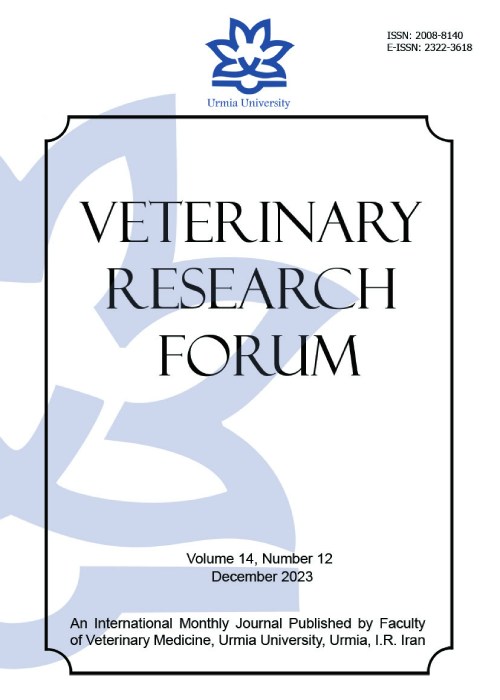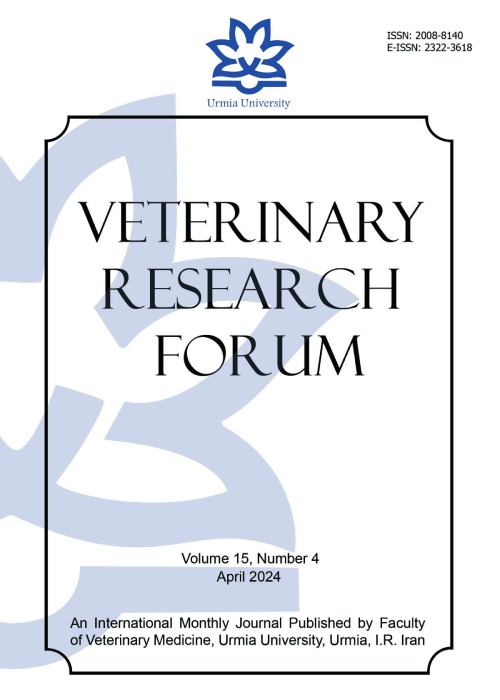فهرست مطالب

Veterinary Research Forum
Volume:14 Issue: 12, Dec 2023
- تاریخ انتشار: 1402/09/10
- تعداد عناوین: 8
-
-
Pages 635-641
World Organization for Animal Health has listed bluetongue (BT) under notifiable diseases. The BT is an arboviral infectious disease of domestic and wild ruminants caused by the bluetongue virus (BTV). Southern states of India had remained the point of attention for BT since first presence in 1964 in Maharashtra. Recently, northern states of India have also been reported positive for BTV in small ruminants. The present study reported the dual infection of BTV serotypes, BTV-12 and -16 in sheep population from Sirsa district of Haryana in the year 2016. After detection and serotyping with Seg-2 specific real time polymerase chain reaction (PCR), the Seg-2 and Seg-6 of BTV were PCR amplified and sequenced. On phylogenetic analysis it was detected to be clustered in nucleotype G and nucleotype B specific for BTV-12 and BTV-16, respectively. This was the first report of BTV-16 from Haryana. The results signified the co-infection of two different serotypes in an animal from a single outbreak.
Keywords: Bluetongue virus, Dual Infection, Goat, Molecular diagnosis, real time RT-PCR -
Pages 643-648Tropical or Mediterranean theileriosis in dairy cattle is widely distributed in many tropical regions of the world. The purpose of this study was to evaluate the proliferation status of mononuclear cells infected with Theileria annulata schizonts in different tissues and its relationship with the pathogenesis of the parasite in cattle by histopathology, immuno-histochemistry and polymerase chain reaction (PCR). Blood and tissue samples of eight Holstein cattle that had been lost due to theileriosis and eight healthy slaughtered cattle of the same breed were collected as a control group after necropsy. The piroplasms in the blood smears and the schizonts in the cytoplasm of the lymphocytes and macrophages of the lymph nodes were microscopically detected. Histopathologically, the proliferation of macrophages, lymphocytes, and plasma cells in lymph nodes and the heart, congestion, and bleeding in the red pulp of the spleen, portal tracts of the liver, interstitial tissue of the kidneys, multifocal necrosis and ulceration in the abomasum together with hyperemia and hemorrhages and lymphoblastic infiltration in the submucosa and lamina propria adjacent to these lesions and emphysema with ecchymotic hemorrhage in the lungs were evident. Immunohistochemistry identified the proliferated cells as mostly Cluster of Differentiation 3- Positive T lymphocytes and macrophage marker antibody 387- positive macrophages. Positive results of PCR for the Tams1 30.00 kDa gene were observed in lymph nodes, liver, lung and abomasum. It was concluded that the pathological changes were the result of schizont-infected macrophage proliferation leading to severe uncontrolled proliferation of uninfected T lymphocytes.Keywords: Cattle, Histopathology, Immunohistochemistry, PCR, Theileria annulata
-
Pages 649-657The genetic diversity of Brucella strains has not been fully understood. To investigate this, the genetic characteristics of 64 isolates of Brucella melitensis from sheep and goats’ milk were studied using random fragment length polymorphism (RFLP) and multiple locus variable-number tandem repeat analysis (MLVA-16) methods developed in Orsay, France (MLVA-16Orsay). The RFLP analysis revealed that all 64 isolates were of biovar one. The MLVA-typing showed that one sample was simultaneously infected with two strains of B. melitensis and the genotype of 65 isolate was analyzed. Four genotypes (47, 42, 43, and 63) were identified using MLVA-8 (panel 1), whereas six genotypes (138, 125, 116, 108, and two unknown genotypes) were identified using MLVA11 (panels 1 and 2A). From the review of MLVA-16 (panels 1, 2A, and 2B), panel 2B showed a very high discriminatory power. Two loci of Bruc04 and Bruc30 from this panel had diversity index values higher than 0.71 and the average diversity index was 0.619. So MLVA-16Orsay 34 showed the genotype indicating a low genetic homogeneity among the isolates. The findings of MLVA genotyping of the isolates suggest that strains of B. melitensis isolated from the milk of small ruminants in Iran are most closely related to the isolates from neighboring countries of the Eastern Mediterranean group. To the best of our knowledge, this is the first study to indicate the potential use of MLVA genotyping for simultaneous detection of specimen contamination using two different B. melitensis biovars.Keywords: Brucella melitensis, Goat, Milk, MLVA, Sheep
-
Pages 659-664The new strategy for vaccine development such as the fused protein multi-epitope capable of preventing the reactivation of latent tuberculosis infection (LTBi) can be an effective strategy for controlling tuberculosis (TB) worldwide. This study was conducted to evaluate the immunity of experimentally infected BALB/c mice with Mycobacterium tuberculosis after injection of DNA construct. Nineteen female BALB/c mice were divided into three groups and injected with 0.50 mL of M. tuberculosis. After 3 weeks, lung and spleen samples from the infected mice were examined. The protective effects of light chain 3-fused protein multi-epitope against TB were evaluated for post-exposure and therapeutic exposure. The lungs and spleens of the mice were aseptically removed after death for histopathology analysis. The bacterial colonies were counted, and the cells were stained after 3 weeks of incubation. No significant differences were observed between the post-exposure and therapeutic exposure groups. The pathological changes in the lung tissue of mice in these groups included an increase in the thickness of interalveolar septa, hyperemia, and intraparenchymal pulmonary hemorrhage centers (positive control), scattered hyperemic areas (negative control), and hyperemia in the interstitial tissue, scattered hyperemic areas in the lung parenchyma and lymphocytic infiltration centers (experimental group). Flow cytometry of the post-exposure and therapeutic exposure models showed insignificant changes in all three groups. It seems necessary to develop a post-exposure and therapeutic exposure vaccine strategy that focuses on LTBi to prevent the progression of the active disease. In this regard, multi-epitope vaccines should be designed to induce both cellular and humoral immunity.Keywords: flow cytometry, Hyperemia, LC3-fused protein multi epitope, tuberculosis
-
Pages 665-671This study designed a protocol that would combine pregnant mare serum gonadotrophin (PMSG) and cabergoline (CAB) to induce estrus in bitches. Twenty clinically healthy adult and anestrous female dogs were randomly assigned into four groups. The first group was treated with 5.00 μg kg-1 CAB until the onset of proestrus or for 25 days. The second group was treated with 20.00 IU kg-1 PMSG for 5 days and 500 IU human chorionic gonadotropin (hCG) on the 5th day. The third group was treated with 5.00 μg kg-1 CAB for 10 days in combination with 20.00 IU kg-1 PMSG for 5 days and 500 IU hCG on the 10th day. The control group received 1.00 mL of normal saline. Ovarian changes were evaluated ultrasonographically, and the estrus cycle phase was examined by vaginal cytology. Respectively, three, three and four bitches showed clinical signs of proestrus in each treatment group. The intervals between treatment and proestrus for each group were 30.00 ± 3.05, 7.67 ± 1.20 and 13.00 ± 1.20 days, respectively. Two weeks after estrus, the progesterone mean was 14.51 ± 6.24, 19.96 ± 17.16 and 19.12 ± 9.26 ng mL-1 for each group, respectively. In ultrasonography examination, the largest follicle was identified at 15.66 ± 1.33, 11.66 ± 2.40 and 8.75 ± 2.17 days after the onset of proestrus and the largest follicle’s size was measured 6.50 ± 0.55, 4.83 ± 1.64 and 7.07 ± 1.49 mm for each group, respectively. Although the combined use of CAB and PMSG reduced the duration of treatment, alteration of the duration or PMSG dosage can be helpful to improve the results.Keywords: Bitches, Cabergoline, Estrus induction, PMSG, Ultrasonography
-
Pages 673-679
Although cryopreservation of ovarian tissue has advanced greatly, it remains a challenge, and protocols should be optimized to handle the heterogeneous nature of ovarian samples. In an effort to address this factor, the present study evaluated the effects of corpus luteum (CL) and side of ovaries (right versus left) on cellular morphology and viability of vitrified bovine ovarian fragments in a closed system. The ovaries were categorized according to whether they had a CL and which side they were on, and then divided into six groups: 1) CL+ (with CL) group; 2) CL˗ (without CL) group; 3) right ovaries group; 4) left ovaries group; 5) fresh control group (ovaries without vitrification or culture that were not selected for CL or ovarian side) and 6) In vitro culture medium control group (non-vitrified ovaries that were not selected for the presence or absence of CL or side of the ovaries). The current study shows that the CL˗ and right groups had the greatest percentage of follicles with normal morphology compared to other vitrified-warmed groups. Furthermore, the levels of necrosis and tissue damage of the right cultured group were the lowest compared to other groups. It was shown that bovine ovarian tissues derived from right ovaries and ovaries without a corpus luteum can be functionally and morphologically preserved after vitrification. For the first time, the present study suggests that bovine ovarian tissue vitrification can be improved by considering the origin of the ovaries.
Keywords: Corpus luteum, Cryopreservation, Immunolocalization, Ovarian tissue, Vitrification -
Pages 681-684
Foot-and-mouth disease (FMD), a highly contagious viral disease of livestock, is endemic in Iran. To investigate the prevalence of antibodies against 3ABC non-structural protein (NSP) of FMD virus, a cross-sectional study was conducted on dairy cattle in eight cities of Kurdistan Province from May to September 2016. Serum samples (n = 283), were collected from cattle vaccinated with the recommended dose of a commercial vaccine and tested by a Competition enzyme-linked immunosorbent assay. Results showed the overall seroprevalence of antibodies against NSP of FMD virus in the vaccinated cattle was 22.30% (95.00% CI: 17.40 - 27.20%). The seroprevalence of antibodies was affected by geographical regions, with the highest seroprevalence related to the samples of vaccinated cattle in the cities of Marivan 95.00% (95.00% CI: 92.50 - 97.50%) and Saqqez 38.50% (95.00% CI: 32.80 - 44.20%). In terms of age, the highest seroprevalence of antibodies to FMD virus 26.70% (95.00% CI: 21.60-31.80%) belonged to ≤ 24-month-old cattle. These findings suggest that the presence of NSP antibodies in vaccinated cattle indicates the risk of infection with FMD virus serotypes circulating in the west of the province, so further studies with a larger sample size are recommended.
Keywords: Cattle, Foot-and-mouth disease, Non-structural protein, Vaccination -
Pages 685-688Moellerella wisconsensis is a Gram-negative, facultative anaerobic bacillus of Entero-bacteriaceae family, and it is an uncommon pathogen in domestic animals. To date, five cases were reported including two dogs, two cattle, and a goat. Streptococcus equisimilis is the second common bacterial agent after the S. equi subsp. zooepidemicus in equine pneumonia cases. The present report describes the isolation of M. wisconses from lungs and spleen of a 10-year-old Arabian horse (May 08, 2022) at post-mortem examination being co-infected with S. equisimilis. Clinical and pathological findings included bilateral nasal discharge, conjunctivitis, sternal recumbency, severe diffuse necrosuppurative rhinitis, multi-focal fibrinopurulent pneumonia and purulent lymphadenitis. Polymerase chain reaction assays showed no viral nucleic acids of equid alphaherpesvirus (EHV) 1, EHV-4, equine arteritis virus and equine papilloma virus. The antibiogram test revealed that the isolate was sensitive to several antibiotics except colistin. Taken together, the present report documents the first isolation of M. wisconsensis from lungs and spleen of a horse; hence, experimental studies are needed to clarify the pathogenity and pathogenesis of M. wisconsensis.Keywords: Equine, Moelerella wisconsensis


